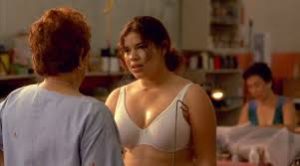
Real Women Have Curves is a coming-of-age, funny, and charming movie that deals with issues of gender by displaying the struggles of poor Hispanic women living in East Los Angeles. The Garcia family is portrayed as the nuclear heteropatriarchy Chicano famliy that Richard Rodriguez describes in Next of Kin which represents the wife-mother as a woma who’s sole purpose in life is to support her husband, raise her children, and be mindlessly obedient to everything she is expected to do as a woman. However, Rodriguez’s thoughts on the Chicano family is evidently interrupted by the character of Ana. Through Rodriguez’s eyes, Ana would most likely be viewed as “antifamilia” because she personally desires liberation from her family, despite her mother’s belief that a woman should not be allowed to think for herself. Throughout the film, Ana is seen stuck in a crossroads due to the fact that the sense of duty to her family, which has been instilled in her throughout her life by her mother, is keeping her from fulfilling her dreams of going to college. Thus, this obligation to fulfill her family duty consequently traps Ana to traditional Latina roles. Still, as the film progresses , Ana is slowly breaking away from these traditional Latin women roles.
Moreover, throughout the film, the mother-daughter relationship that Rodriguez also highlights in his text is being testes. Ana is seen constantly arguing with her mothet Carmen over one another’s ideas of what a “real woman” is and looks like. The definition of “real woman” “is essentially the main theme of the film, as suggested in the title. While Carmen believes that a real woman is someone who is young and thin, and who is defined by her husband, Ana believes the opposite. She believes that a woman is more than her weight, sexuality, and her servitude to her husband. The movie displays a diverse group of Latinas, in regards to beauty, to try to determine this definition; yet, regardless, the movie ends up validating Ana’s perspective by allowing her to be accepted for who she is, and then attaining independence by defying her mother and departing from her family.
All in all, the character of Ana is used in the film as a feminist critique of Latin cultural norms that pressure women into serving the heteropatriarchy. For the most part, the women, in general, are portrayed as women who have given up on their dreams in exchange for patriarchal servitude. But, then, there’s Ana, who is the opposite, who is able to lead these women into slowly realizing the errors of their ways at the end. This is shown after the women follow in Ana’s lead in taking off their shirts as a way of liberation. Although, Carmen trys her best to convince Ana to compromise her personal independence and accept a traditional life of humble labor and enslavement to a man, fortunately, Ana is able to reinforce the feminist message that nothing and nobody can take a woman’s independence away. Therefore, Ana becomes a representative of the real woman that the film desires to define through liberating herself from patriarchy by pursuing personal fulfillment that patriarchy opposes.
My personal opinion of Real Women Have Curves is mostly positive. I can relate to Ana, both in her views of a “real woman” and by pursuing a college education instead of becoming another Latina cliché. It’s also refreshing to see a woman who is not white or thin in film who is just as talented as the actors who had defined beauty in Hollywood at the time of production. I would recommend this movie to all the young Latinas out there as inspiration to find themselves despite the pressure to stick to cultural or familial norms. Real Women Have Curves provides women the opportunity to open their eyes to the wickedness of patriarchy in the same way Ana opens her eyes.
